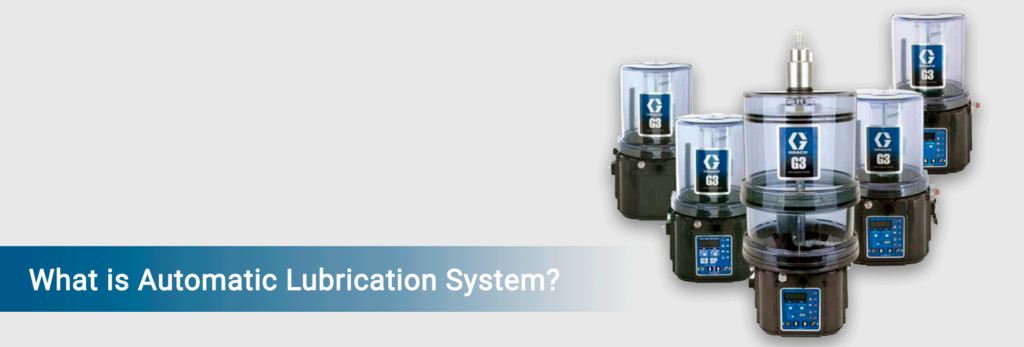An Automatic Lubrication System or Automatic Grease system is a device that delivers precise amounts of lubricant to specific lubrication points in your machine.
Unlike the traditional method of manually applying grease with a grease gun, an ALS automatically ensures it gets the lubrication it needs exactly when it needs it. There are different types of lubrication systems available, but their core function remains the same: To keep your machine operating smoothly and efficiently.
How Does an Automatic Lubrication System Work?
An ALS typically consists of several key components working together such as:
- Reservoir: This acts as the storage tank for your lubricant to ensure a steady supply.
- Pump: The pump pressurizes the lubricant and pushes it through the system. The most commonly used pumps are either electric or gear-driven pumps.
- Dividers/Distributors: These components ensure the lubricant reaches the designated points in your machine.
- Metering Devices: These instruments control the exact amount of lubricant delivered to each point.It ensures there is no over-lubrication.
- Lines and Fittings: This network carries the lubricant throughout your machine.
This greasing system operates based on a pre-programmed schedule or through signals from the machine itself. The lubricant is then delivered in measured doses to each lubrication point which ensures optimal performance and wear protection.
Benefits of ALS
There are many advantages to using an automatic lubrication system compared to manual lubrication such as:
- High Performance: Consistent and appropriate lubrication reduces friction and improves efficiency.
- Increased life: Reduced level of normal lubrication of machine parts thus prolonging the life of the machine.
- Reduced downtime: Passive lubrication saves the company time.
- Reduced maintenance costs: You save money on maintenance by eliminating the need for manual lubrication and preventing damage due to improper lubricants.
- Improved safety: ALS eliminates the need for workers to enter potentially hazardous areas to lubricate machinery which reduces the risk of accidents and injuries.
- Increased productivity: ALS keeps your machine running smoothly that maximise productivity.
- Reduced Environmental Impact: ALS eliminates the risk of excess grease and potential spills that reduce the environmental impact.
Applications of Automatic Grease Systems
Automatic Grease Systems are a valuable asset across various industries such as:
- Manufacturing: Manufacturing processes, machine tools and robotic systems all benefit from the consistent lubrication provided by this lubrication system.
- Construction: Heavy equipment for construction work in harsh environments. ALS ensures that it is supplemented with the right amount of lubrication for proper functioning and longevity.
- Agriculture: Agricultural machinery such as tractors, harvesters and irrigation systems rely on proper lubricants to function properly. ALS automates this process which streamlines field operations.
- Mining: Machinery used in these areas suffers severe damage. This lubrication system ensures proper lubrication which reduces downtime and maintenance costs.
- Food and Beverage: In hygienic areas, such as food and beverage facilities, ALS ensures that clean and safe oils are used without the risk of contamination.
- Transportation: Passenger vehicles like trucks, buses and other commercial vehicles need regular lubrication. Automatic greasing automates this process and makes it more efficient and safe.
Choosing the Right Automatic Lubrication System
Selecting the right ALS for your needs depends on several factors such as:
- Machine type and size: Different machines have different lubrication requirements. Consider the size and complexity of your equipment when choosing a lubrication system.
- Lubrication points and requirements: The number and location of lubrication points on your machine will influence the design of your system.
- Operating environment: Factors like temperature, dust, and moisture can impact the type of lubrication system best suited for your needs.
- Desired features: Automatic Lubrication System solutions come in various configurations with different features. Choose the one as per your requirements.
- Budget: Consider your budget and the specific features you require.
For a top-notch Automatic Lubrication System at a reasonable price, get in touch with Patvin. We are the leading provider of high-quality ALS solutions designed to meet the diverse needs of various industries over a decade.
Our lubricating systems capture critical data that can be used to simplify other tasks for key decision-makers. As a result, our comprehensive automatic lubrication offering features market-leading innovation and reliability.
For more details, get in touch with our experts! Our experienced technicians can provide professional installation services to ensure your system is up and running smoothly.
FAQs
Installation complexity depends on the size and complexity of the chosen ALS. In terms of maintenance, ALS typically requires minimal maintenance compared to manual lubrication. Regular inspections and refilling the lubricant reservoir are the key tasks.
The cost of an ALS varies depending on several factors, including the size and complexity of the system, the number of lubrication points, and the desired features. However, the long-term benefits of ALS, such as reduced downtime, extended equipment life, and improved safety, often outweigh the initial investment.
The refill frequency for an ALS depends on the lubricant consumption rate of your machinery and the system’s reservoir capacity. Generally, ALS reservoirs are designed for extended operation between refills. Factors like operating conditions and machine workload can influence refill frequency.
Yes, Automatic Lubrication Systems can be environment friendly. They eliminate the risk of over-lubrication, which can lead to lubricant spills and contamination. Some ALS are designed with biodegradable lubricants, further reducing environmental impact.



